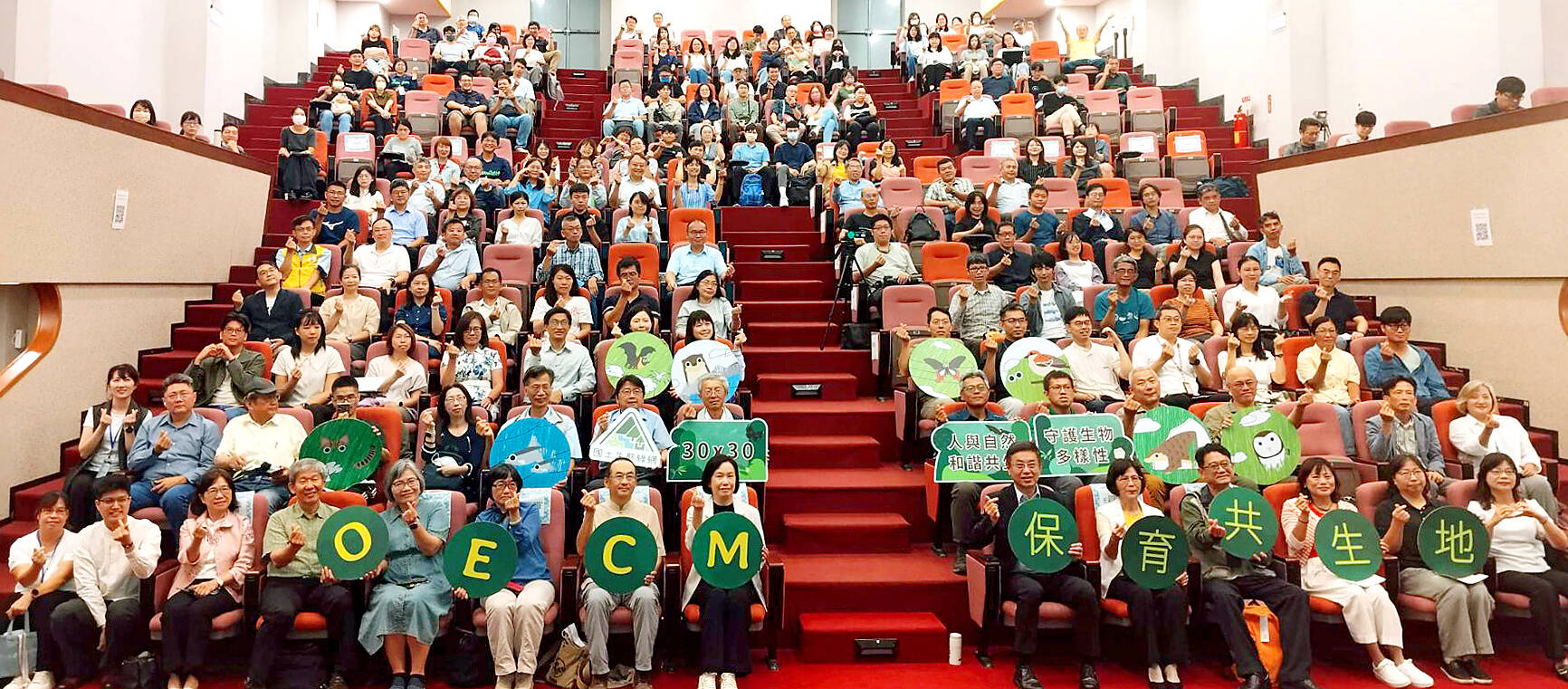The Forestry and Nature Conservation Agency yesterday launched a certification scheme aimed at contributing to global efforts to conserve 30 percent of the Earth’s terrestrial and aquatic areas by 2030.
The Terrestrial Other Effective Area-Based Conservation Measures (OECM) certification is part of efforts to meet the Kunming-Montreal Global Biodiversity Framework’s goal, dubbed the “30 by 30” target.
Agency Director-General Lin Hwa-ching (林華慶) told a news conference that protected areas and OECMs are recognized as effective conservation that can add up to the target.

Photo: CNA
Most protected areas in Taiwan are public or national land, as the incorporation of private land often faces pushback, he said.
OECM sites are not legal nature reserves and use of the land would not be legally restricted, as long as their biodiversity resources can be sustainably conserved, and local cultural, spiritual, social and economic values can be preserved, Lin said.
“They are places where humans and nature coexist and would not exclude the ‘people element’ the way traditional [nature reserve] enclosures do,” he added.
Government-led conservation and development of private land biodiversity resources can be traced to the introduction of the Satoyama Initiative in 2011, which guided local residents in managing and protecting natural resources based on the concept of community forestry, Lin said.
Although Taiwan is not a UN member, the government is committed to achieving the “30 by 30” target and is planning for several new protected areas, he said.
About 19 percent of the more than 1.5 million hectares of national forests have already been demarcated as protected areas, including national parks, Lin said, adding that a large part of national forests are protection forests, which are less explored and could be included.
Aside from these existing or potential protected areas, more public or private land would be included through the terrestrial OECM scheme to meet the target, he said.
Based on the previously launched Taiwan Ecological Network Construction Project, natural resource governance areas, indigenous peoples, local communities, urban green and blue spaces, and conservation corridors would be prioritized for OECM certification, Lin said.
Other potential OECM sites, such as green space in science parks or industrial areas, could also be repurposed as refugia or ecological stepping stones, he added.
Nature Conservation Management Division technical specialist Chang Chin-chia (張晉嘉) said people and legal entities can apply for OECM certification.
Candidate OECM sites cannot be located within a protected nature reserve and should align with as many biodiversity values as possible, he said.
They are required to have a management system that is effective in the long run and must obtain consent from primary stakeholders about the certification and management plan, Chang said, adding that the first application session has started and would run through Aug. 15.
Deputy Minister of Agriculture Tu Wen-jane (杜文珍) said that ecological conservation and natural sustainability should not be limited to nature reserves or national forests.
“Anyone who owns land, whether it is in the countryside, in the mountains or in a city, has the opportunity to take part in ecological conservation — that is the spirit of OECMs,” she said.
Asked whether OECM certification would be accompanied by legal protection, Lin said that OECM sites would not have extra protection from the government, as they are not protected areas.
The goal is to facilitate biodiversity resource conservation through the help of the public and prompt them to internalize the spirit, he said, adding that companies would also support the policy, as they can include OECM investments in their environmental, social and governance reports.

Trips for more than 100,000 international and domestic air travelers could be disrupted as China launches a military exercise around Taiwan today, Taiwan’s Civil Aviation Administration (CAA) said yesterday. The exercise could affect nearly 900 flights scheduled to enter the Taipei Flight Information Region (FIR) during the exercise window, it added. A notice issued by the Chinese Civil Aviation Administration showed there would be seven temporary zones around the Taiwan Strait which would be used for live-fire exercises, lasting from 8am to 6pm today. All aircraft are prohibited from entering during exercise, it says. Taipei FIR has 14 international air routes and

The Ministry of National Defense (MND) today released images of the military tracking China’s People's Liberation Army (PLA) movements during the latest round of Chinese drills around Taiwan. The PLA began "Justice Mission 2025" drills today, carrying out live-fire drills, simulated strikes on land and maritime targets, and exercises to blockade the nation's main ports. The exercises are to continue tomorrow, with the PLA announcing sea and air space restrictions for five zones around Taiwan for 10 hours starting from 8:30am. The ministry today released images showing a Chinese J-16 fighter jet tracked by a F-16V Block 20 jet and the

City buses in Taipei and New Taipei City, as well as the Taipei MRT, would on Saturday begin accepting QR code payments from five electronic payment providers, the Taipei Department of Transportation said yesterday. The new option would allow passengers to use the “transportation QR code” feature from EasyWallet, iPass Money, iCash Pay, Jkopay or PXPay Plus. Passengers should open their preferred electronic payment app, select the “transportation code” — not the regular payment code — unlock it, and scan the code at ticket readers or gates, General Planning Division Director-General Liu Kuo-chu (劉國著) said. People should move through the

Snow fell on Yushan (Jade Mountain, 玉山) yesterday morning as a continental cold air mass sent temperatures below freezing on Taiwan’s tallest peak, the Central Weather Administration (CWA) said. Snowflakes were seen on Yushan’s north peak from 6:28am to 6:38am, but they did not fully cover the ground and no accumulation was recorded, the CWA said. As of 7:42am, the lowest temperature recorded across Taiwan was minus-5.5°C at Yushan’s Fengkou observatory and minus-4.7°C at the Yushan observatory, CWA data showed. On Hehuanshan (合歡山) in Nantou County, a low of 1.3°C was recorded at 6:39pm, when ice pellets fell at Songsyue Lodge (松雪樓), a